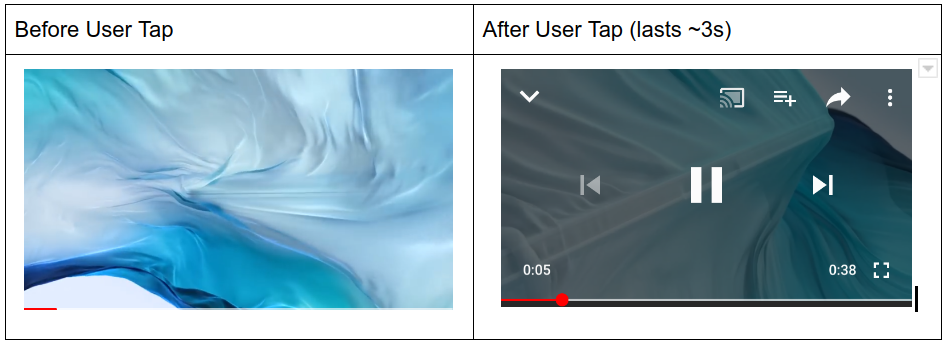Android 適用的 IMA SDK 包含Open Measurement (OM) SDK,這是互動廣告協會 (IAB) 開發的業界標準,可評估第三方可視度和驗證。使用 Android 適用的 IMA SDK 時,內含的 OM SDK 會自動剖析 VAST 廣告代碼中的 <AdVerifications> 代碼,並使用 OMID API 將可視度資料傳送給指定的評估廠商。IMA SDK 支援 OM SDK v1.4、VAST 2 以上版本的 GAM AdVerifications 擴充功能,以及 VAST 4 以上版本的 AdVerifications 節點。如要使用開放式評估功能,請注意下列事項:
如要使用 Open Measurement,您必須具備 Android 專用 IMA SDK 3.11.0 以上版本。不過,本指南中的範例是為最新版 SDK 設計,並包含 3.16.5 版導入的 API。
如果使用 VAST 4.1 以上版本,廣告必須設定為在 VAST 中放送
<AdVerifications>,詳情請參閱 VAST 4.1 規格;否則應使用<Extension type="AdVerifications">。請勿使用任何疊加層 (透明或不透明) 遮蓋
AdDisplayContainer,否則 OM SDK 會將這些疊加層標示為障礙物,進而降低可視度。
必要條件
- 如果廣告是透過 Ad Manager 放送,請為 Ad Manager 聯播網設定可視度評估服務供應商,並將該供應商指派給委刊項。
測試
如要使用 IMA SDK 測試開放式評估,請使用支援 OM SDK 的 IMA 版本,以及測試廣告代碼。
您應該會在 VAST 回應中看到 <AdVerifications>。
註冊影片控制項重疊障礙
暫停按鈕或進度列等影片控制項可為使用者提供重要的播放資訊和動作。在行動裝置上,由於輕觸不精確和使用者期望等因素,在媒體元素上算繪大型觸控友善控制項已成為常見做法。這些控制項通常會在使用者輕觸時淡入和淡出,且在大部分的播放時間內都不會顯示。
如要查看影片控制項重疊的範例,請參閱 YouTube 應用程式的控制項顯示畫面:

使用 IMA SDK 時,大多數發布商會透過在廣告顯示容器上方新增幾乎透明的檢視區塊,實作這些控制項。通常,控制項是這個檢視區塊的子項元素,會完全遮蔽底層的影片播放器。這個透明疊加層可用來擷取輕觸事件,並在使用者輕觸時向他們顯示控制項。
使用 Open Measurement SDK 計算廣告可視度時,系統會將所有重疊在媒體元素上的檢視畫面視為阻礙,並降低可視度率。如果透明輕觸重疊層位於整個廣告顯示容器上方,則可能會將廣告空間宣告為完全無法觀看。
Open Measurement SDK 會將影片控制項視為「無害」的遮蔽物,因為這類控制項對使用者體驗至關重要。註冊為友善控制項後,這些控制項就不會納入廣告可視度評估。
IMA SDK 支援 IAB 和 MRC,並推出 API,可向 Open Measurement SDK 註冊這些重疊畫面。這些控制項必須是完全透明的疊加層或小按鈕。與影片控制項無關的任何其他檢視畫面不得註冊。
| DO 註冊 | 請勿註冊 |
|---|---|
|
|
下列程式碼範例示範如何在廣告顯示容器上註冊影片控制項疊加層:
private void registerFriendlyObstructions(
AdDisplayContainer adDisplayContainer, View transparentTapOverlay, View pauseButton) {
ImaSdkFactory imaSdkFactory = ImaSdkFactory.getInstance();
// Make sure to register all friendly obstructions before ad playback starts.
FriendlyObstruction overlayObstruction =
imaSdkFactory.createFriendlyObstruction(
transparentTapOverlay,
FriendlyObstructionPurpose.NOT_VISIBLE,
"This overlay is transparent");
FriendlyObstruction pauseButtonObstruction =
imaSdkFactory.createFriendlyObstruction(
pauseButton,
FriendlyObstructionPurpose.VIDEO_CONTROLS,
"This is the video player pause button");
adDisplayContainer.registerFriendlyObstruction(overlayObstruction);
adDisplayContainer.registerFriendlyObstruction(pauseButtonObstruction);
}
完成後,呼叫下列方法即可移除這些障礙物:
private void unregisterFriendlyObstructions(AdDisplayContainer adDisplayContainer) {
adDisplayContainer.unregisterAllFriendlyObstructions();
}
